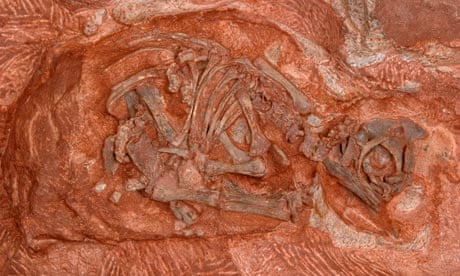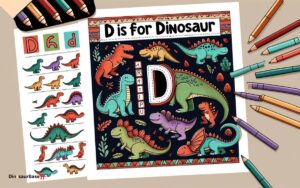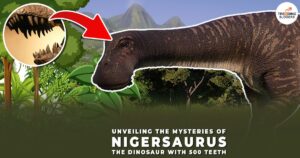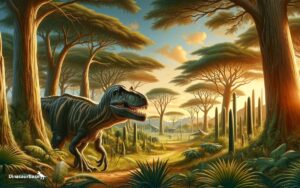Which Dinosaur Is the Oldest? Discover the Ancient Origins!
The oldest known dinosaur is Nyasasaurus parringtoni. This dinosaur lived during the Middle Triassic period.
Discovering the origins of dinosaurs ignites the curiosity of paleontologists and enthusiasts alike. Nyasasaurus parringtoni, unearthed from what is now Tanzania, dates back approximately 243 million years. This fascinating creature provides a critical piece of the puzzle in understanding dinosaur evolution.
Scientists believe it establishes the presence of dinosaurs earlier than previously thought, marking a significant milestone in the prehistoric timeline. Its discovery challenges earlier conceptions and shapes new narratives about the age in which dinosaurs started to dominate the Earth. The study of Nyasasaurus parringtoni not only sheds light on the distant past but also encourages ongoing research to fine-tune our historical and biological knowledge of these remarkable creatures that once roamed our planet.

Credit: www.nbcnews.com

Unearthing The First Dinosaurs
You might have seen dinosaurs in movies. But which of these giants walked the Earth first? Scientists have been using clues from fossils to find out. Let’s dive into the journey of discovering the oldest dinosaurs.
Digging Into Prehistoric Timelines
Finding the oldest dinosaur requires going back in time. Think of it like a huge puzzle. Every fossil is a piece. Scientists use these pieces to create a timeline. This timeline helps us understand when dinosaurs lived. Scientists look at rock layers and where fossils are found in them. The deeper the layer, the older it is.
Criteria For Determining Age
So, how do we figure out how old a fossil is? Scientists use a few methods:
- Radiometric dating: This technique measures the decay of radioactive elements within the fossil or the rock surrounding it.
- Relative dating: Here, scientists compare the fossil’s layer to other layers. This gives them a rough idea of its age.
- Index fossils: These are fossils known to have lived during a specific time. Scientists use them as markers to date other fossils.
By using these methods, scientists identified Eoraptor and Herrerasaurus as some of the oldest known dinosaurs. These creatures roamed the Earth around 230 million years ago!
Ancient Behemoths Of The Triassic
The Triassic Period was a time of colossal change. Marking the dawn of the Age of Dinosaurs, it unfurled the red carpet for Earth’s first fearsome reptilian giants. Let’s journey back over 200 million years to meet these ancient behemoths.
Introducing Triassic Dinosaurs
The Triassic era’s landscape teemed with life, witnessing the emergence of earliest known dinosaurs. Here are a few that set the stage for those to follow:
- Eoraptor – A swift-moving carnivore
- Plateosaurus – An early giant herbivore
- Herrerasaurus – A formidable predator
These pioneer species carved the path for the diverse lineage of dinosaurs, demonstrating survival traits that proved essential in the eons to come.
Distinctive Features Of Early Dinosaurs
Despite their variety, early dinosaurs shared certain distinctive features:
| Feature | Description |
|---|---|
| Three-toed feet | Optimized for walking and running |
| Hollow bones | Made for a lightweight framework |
| Straight legs beneath the body | Provided better support and mobility |
These characteristics set them apart from their reptilian cousins and gave them an evolutionary edge. From their stance to their physiology, early dinosaurs were built to dominate.
Eoraptor And Herrerasaurus: Contenders For The Crown
The quest to uncover the oldest dinosaur has fascinated scientists for decades. Two remarkable species, Eoraptor and Herrerasaurus, often emerge as front-runners in this prehistoric mystery. These ancient creatures offer incredible insights into the dawn of the dinosaurs.
Examining Eoraptor’s Legacy
Eoraptor, a name meaning “dawn plunderer,” stands out as a significant find. Discovered in Argentina, its fossils date back roughly 231 million years. Experts regard Eoraptor as one of the earliest dinosaurs for its primitive features and small, agile body.
- Location: Argentina
- Age: ~231 million years
- Distinguishing Features: Bipedal stance, sharp teeth, and clawed hands
Clad in a powerful form, the Eoraptor’s characteristics suggest a carnivorous diet. As one of the first dinosaurs, its kind helps trace the family tree of these colossal beings.
The Case For Herrerasaurus
Herrerasaurus steps up as another potential ancient ruler. Found in the same region as Eoraptor, this dinosaur is equally as old. Herrerasaurus exhibits a form closer to later dinosaurs, making its candidacy intriguing.
| Feature | Description |
|---|---|
| Size | Larger than Eoraptor, with a more robust build |
| Diet | Assumed carnivorous, with strong jaws |
| Unique Qualities | Advanced hips and legs for its time |
The case for Herrerasaurus hinges on its advanced skeletal structure. These features might indicate a later stage in dinosaur evolution, despite its age. This duality makes Herrerasaurus a strong contender in the race.
Between Eoraptor and Herrerasaurus, the answer to the oldest dinosaur may still be up for debate. Each has a rightful claim to the crown, fascinating paleontologists and enthusiasts around the world.

Credit: www.newscientist.com
Reconstructing Prehistoric Life
Reconstructing Prehistoric Life dives deep into the age-old question: which dinosaur roamed Earth first? This journey takes us back millions of years, as we piece together the puzzles left behind by these astonishing creatures. With each fossil and footprint, we unmask the mysteries of a world long extinct. Let’s explore the innovative techniques and evolving hypotheses that bring us closer to understanding the oldest dinosaur.
Paleontological Methods And Tools
To unearth the secrets of prehistoric dinosaurs, scientists use a variety of cutting-edge methods and tools:
- Excavation tools: From shovels to tiny brushes, these instruments carefully reveal fragile fossils.
- Mapping technology: High-tech mapping devices capture the precise location of finds.
- Dating techniques: Methods like radiometric dating determine fossil ages with remarkable accuracy.
- Computed Tomography (CT) scans: Scans allow us to peek inside fossils without damaging them.
- 3D modeling software: This tech reshapes fragments into complete dinosaur models.
New Discoveries And Changing Theories
New discoveries continually reshape our understanding of the oldest dinosaurs:
- Eoraptor once thought to be the oldest, dates back 231 million years.
- Nyasasaurus parringtoni, with recently unearthed evidence, might predate Eoraptor by 10 million years.
- Asilisaurus kongwe, also a contender, challenges the dinosaur timeline even further.
Theories evolve as new evidence emerges, highlighting the ever-changing nature of paleontological research.
Continental Drift And Dinosaur Evolution
The story of the dinosaurs is as fascinating as it is ancient. As paleontologists dig deeper into the Earth’s layers, they uncover secrets from millions of years ago. One pivotal factor in the evolution of dinosaurs is continental drift. This geological phenomenon reshaped the habitats and the very existence of these prehistoric giants. Let’s explore how shifting continents impacted their lives and led to a diverse range of species.
Linking Tectonic Shifts To Dinosaur Habitats
Tectonic shifts gradually moved the Earth’s continents over vast geological timeframes. This movement changed environments and affected dinosaur habitats. It led to the creation of new ecological niches and new challenges for survival.
- Isolation: As landmasses drifted apart, populations were separated.
- Climate Changes: Shifts caused changes in climate and vegetation.
- Migration Patterns: Altered routes for dinosaur migration.
Influence On Speciation And Diversity
Separated by vast oceans, dinosaur populations started to diverge genetically. This phenomenon, known as speciation, gave rise to an incredible variety of forms. Diverse environments selected for different traits, resulting in the adaptation of species to their unique habitats.
| Factor | Impact on Dinosaurs |
|---|---|
| Ecosystem Variability | Triggered the emergence of specialized diets and behaviors. |
| Predation and Competition | Led to evolved defense mechanisms and hunting strategies. |

Credit: www.livescience.com
Living Descendants Of Ancient Dinosaurs
The mystery of dinosaur history is not just confined to the giants that roamed the Earth millions of years ago. Incredibly, it extends into the modern age through living descendants of those ancient creatures. Yes, several species today carry the legacy of the oldest dinosaurs, offering us a living link to the prehistoric past.
The Connection Between Birds And Dinosaurs
Birds are, in fact, direct descendants of dinosaurs. The discovery of fossils with both feathers and other dinosaur features made scientists rethink the dinosaur family tree. Many characteristics of birds, like wishbones and three-toed limbs, were shared by theropod dinosaurs. Theropods include well-known species like Tyrannosaurus rex and Velociraptor. Studies show that birds evolved from small, feathered, meat-eating dinosaurs during the Jurassic period. This means every bird singing in your backyard can trace its ancestry back to the times when massive creatures dominated the Earth.
Modern Species That Echo The Past
Several modern species have physical features and behaviors reminiscent of their prehistoric ancestors. Let’s look at a few examples:
- Cassowaries – These birds, with their intimidating claws and powerful legs, remind us of the velociraptors from popular culture.
- Shoebill Storks – Known for their fossil-like beaks, these birds resemble the ancient flying reptiles.
- Chickens – Surprisingly, research has shown that the genetic makeup of chickens is very close to that of T. rex!
Not only in physical resemblance but also in their behaviors, such as nesting habits and social dynamics, these modern species provide a living window to prehistoric times. Observing them is like looking directly at pages from the earth’s ancient history book.
| Descendant | Prehistoric Feature | Modern Example |
|---|---|---|
| Birds | Feathers | Eagles, sparrows, parrots |
| Theropods | Three-toed limbs | Ostriches, emus |
| Flying reptiles | Fossil-like beaks | Shoebill storks, pelicans |
These remarkable animals are not just reminders of our planet’s rich history; they are proof of nature’s remarkable ability to adapt and evolve over the course of millions of years. Next time you spot a bird in flight, remember it’s a tiny, yet mighty, representative of the age of dinosaurs. In essence, we are surrounded by living proof that dinosaurs have never fully left us and continue to influence our world.
Frequently Asked Questions Of Which Dinosaur Is The Oldest
What Is The Oldest Dinosaur In The World?
The oldest known dinosaur is the Nyasasaurus parringtoni, believed to have lived around 243 million years ago.
When Were Dinosaurs First On Earth?
Dinosaurs first appeared on Earth approximately 230 million years ago during the Triassic period. They thrived for about 165 million years.
What Was The First Dinosaur Ever Found?
The first dinosaur recognized by science was Megalosaurus, discovered in 1824. This carnivorous dinosaur’s fossils were found in Southern England.
Which Dinosaur Lived The Longest?
The exact dinosaur species that lived the longest is not definitively known due to the fossil record’s limitations. Some sauropods, like Apatosaurus and Brachiosaurus, may have had exceptionally long lifespans, potentially exceeding 100 years.
Conclusion
Unearthing the mysteries of prehistoric times has led us to the impressive Eoraptor. This ancient reptile, thought to be the earliest known dinosaur, offers invaluable insights into the Jurassic era. As we continue to excavate and study, our understanding of these magnificent creatures and their evolution only deepens.
Remember, each fossil discovery is a crucial piece to the grand puzzle of our planet’s vibrant history.





